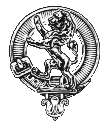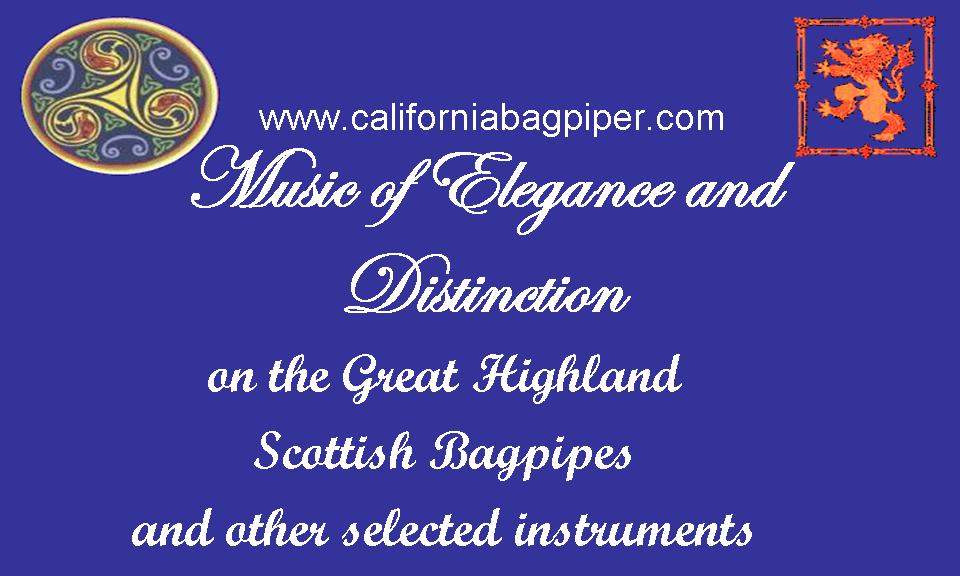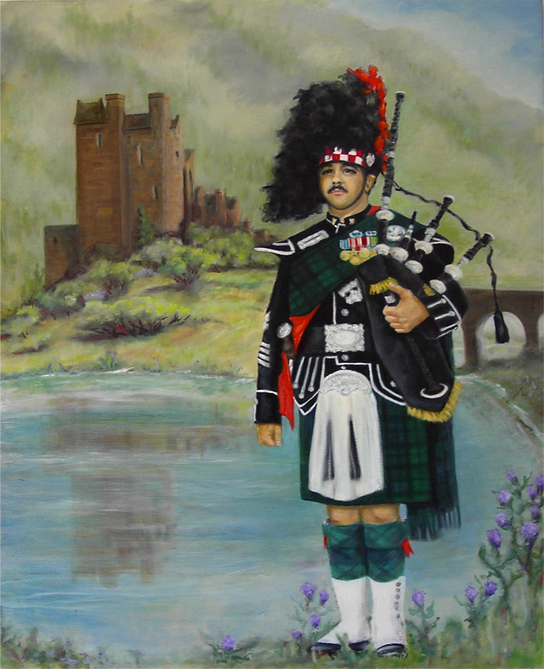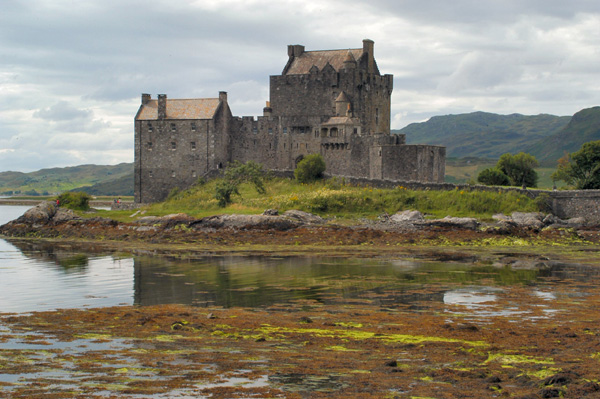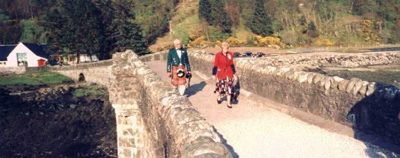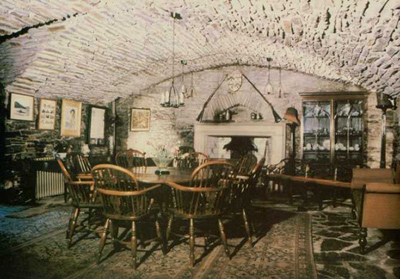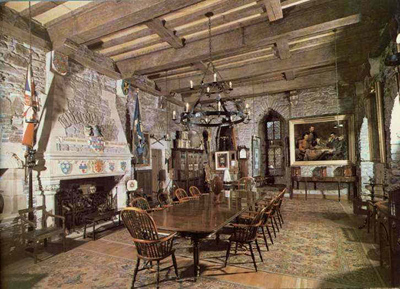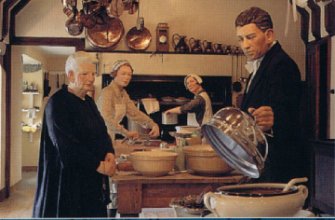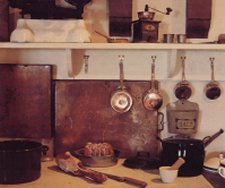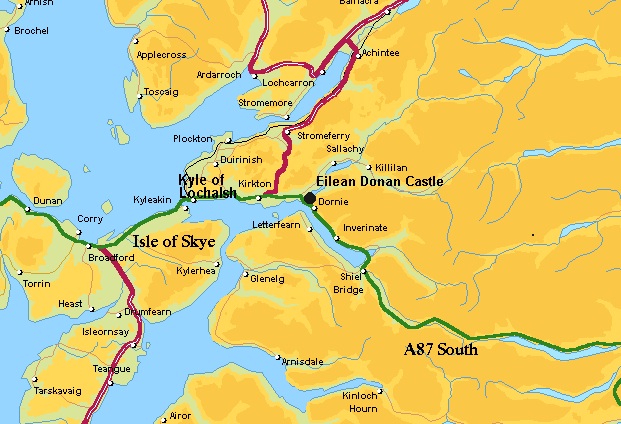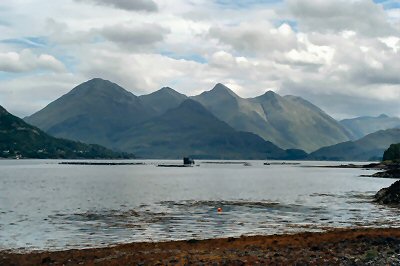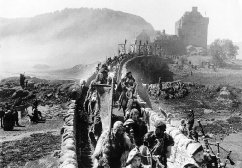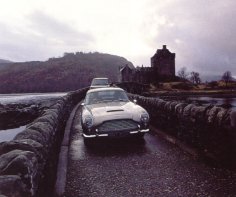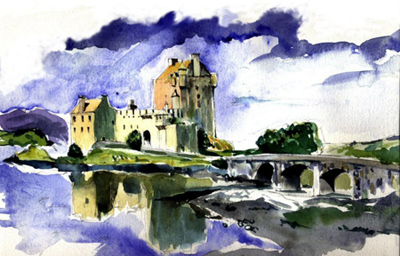|
|
 |
|
| Pipe Major Dr. Raphael Pazo - Eilean Donan Castle |
|
|
| An Oil-On-Canvas portait painting by Jean Justeau |
Scotland's Most Romantic Castle
THE HISTORY OF EILEAN DONAN CASTLE
Over a thousand years before the medieval surveyor
marked out the lines of the fortifications that we see today, the vitrified defenses of an earlier fortification encircled
the small knoll on the island. Apart from some relic fragments of these early defenses beside the castle walls, the precise
line of the earlier fort is buried beneath the castle.
The mediaeval castle was formerly one of the most important
strongholds along the western seas. It was built shortly after the Battle of Largs, when the Scandinavian Crown lost title
to these shores, reputedly as a base for the heritors of the area, the Earls of Ross, to ensure that it was never again lost
to the Scottish Crown. Tradition reports how, though built for the Earls of Ross, by the later 13th century his nephew, Kenneth
McKenzie had, through a crushing defeat of his uncle's forces turned his residency into ownership. By the time of Kenneth's
death in 1304 the Crown had settled the Barony of Kintail on Kenneth.
Tradition relates that Robert the Bruce was given shelter
here, but less welcome was the visit by Randolph, Earl of Moray and Warden of all Scotland in 1331. To mark the arrival of
this strict disciplinarian, fifty "miscreants" were executed and their heads placed upon the walls of the castle. Greatly
pleased, he claimed that the sight of Justice so displayed was sweeter to him than any garland of roses.
The Earldom of Ross continued to press it's claims
to the castle, and, in 1350 went so far as to seize the MacKenzie chief (another Kenneth), and execute him at Inverness. Kenneth's
heir was quickly dispatched to the Western Isles until confirmed in his title to the lands by David II. By this time the clan
Macrae, destined to be the MacKenzies "Coat of Mail", had settled in the district, followed shortly thereafter by the clan
MacLennan.
The first half of the 16th century was a difficult
and dangerous time for the MacKenzies and their castle. In 1497 one hector Roy MacKenzie became Tutor (or Guardian) to John,
a minor, and had to be dislodged by law after involving the family in feuding with both the Crown and other clans. In 1539
the MacKenzies joined with the MacLeods in disputing Donald Gorm MacDonald of Sleat's claim to the Lordship of the isles. MacDonald sailed with fifty ships
to lay siege to the castle, which was occupied at the time only by the Constable, John Dubh Matheson, and a "watchman". Duncan
MacRae who was passing as the fleet approached hastened to the aid of the beleaguered pair. The Constable was shot by an arrow
and killed, and before long Duncan Macrae was reduced to a single arrow that he resolved to hold onto for the time being.
Sensing victory, Donald Gorm MacDonald ordered up a battering ram, and, on passing close to the curtain wall, Duncan Macrae
seized his chance and fired the single arrow. It embedded itself deep in the foot of the chief, who in the heat of impending
victory impatiently wrenched it out. The sharp barbs severed the artery, and unable to staunch the flow of blood their chief
bled to death. With the lifting of the siege Duncan harboured hopes that his action might win him the position of Constable
from the grateful Chief. However, the Chief apparently thought otherwise, and in a pique Duncan left the district, after first
marrying the widow of John Matheson, the former Constable of Eilean Donan.
As Earls of Seaforth, the MacKenzies gave their support
to the Royalist cause. After the execution of Charles I the Scottish Parliament was sufficiently concerned to impose a garrison
at Eilean Donan. They treated the locals very badly, and, as winter advanced, demanded that wood be provided by them. A party
of thirty, led by an officer, John Campbell, and Blytheman, his sergeant, set off to enforce their demands. On being met by
a deputation of ten locals there to complain, Campbell ordered his men to open fire. No-one was hurt, but passions were inflamed
. Drawing their swords the Kintail men fell upon the soldiers. A single stroke severed Campbell's head, right arm, and shoulder
from the rest of his body. Blytheman was killed at a stream, and several other soldiers died as the remainder put to flight.
In 1645 retribution of a sort occurred when Cromwell's Lieutenant, General Monk, arrived and plundering the district, set
houses alight and killed one Duncan Macrae, an old soldier whose death "by the sword" was said to have been told
by Coinneach Odhar.
During the rising of 1715, Government forces were again
stationed in the castle, but were dislodged by the men of Kintail. On the eve of Sherrifmuir a great dance was held on the
roof before the men set out to a defeat that was to leave fifty-eight widows in the district. It was about this time that
brigadier Louis Petit Des Etans was sent by the government to make a plan of castles in the West Highlands that might be used
as centers of disaffection by the Highlanders. In view of what was it happen to the castle within just a few short years of
his visit, the plan he made of Eilean Donan is an invaluable record of the later mediaeval works.
In 1719 a foolhardy Jacobite plot was launched to recover
the defeat of 1715 that was to result in the destruction of much of the castle.
For two centuries it stood as a picturesque ruin,
its history and it's former grandeur embellished by all who passed by. Between 1912 and 1932 it was restored by Farquhar Macrae
of Auchtertyre for it's new owner , Lt. Colonel MacRae-Gilstrap. It is said the form of the reconstruction was revealed to
farquhar in a dream. It is certainly remarkable that it so faithfully follows what Louis Petit's illustration records, though
the latter's drawings were not discovered until long after the reconstruction was complete.
Eilean Donan Castle - A Magnificent Fortification
| Eilean Donan Castle |
|
|
| Scotland's Most Romantic Castle |
In a superbly romantic setting amid silent, tree-clad hills, Eilean Donan Castle
possesses a rare and dream like quality. Yet, standing lone sentinel on its rocky promontory at the meeting point of three
sea lochs - Loch Long, Loch Duich and Loch Alsh - it is, in reality, a fortress of solid stone and formidable defences.
It is not hard to realise the position commanded by the Castle during the troubled
times of the marauding Norse and Danish adventurers who raided along these coasts. Nor is it difficult, when gazing down today
from the heights above the shore of the loch, to visualise an era of savage but somehow glorious warfare, when the Clans fought
and the MacRaes found refuge in this impregnable fortress, defying the attacks of their enemies.
Much of the history of the castle has been preserved within its solid walls and
immortalised in the ballads and stories handed down from generation to generation.
The beginnings of Eilean Donan Castle reach back into the early mists of time. Evidence
of a pictish fort was found in vitrified rock uncovered during excavations-some of which has been kept for visitors to see.
At the beginning of the seventh century St Donan (d.618) lived on the island as a religious hermit: the name "Eilean Donan"
means "Island of Donan". This was the period when Christianity was first introduced to the Western Isles.
The first fortified stronghold was established in the reign of Alexander II (1214-1250).
In 1263 Alexander III gave the castle to Colin Fitzgerald, son of the Earl of Desmond and Kildare (later to become MacKenzies)
as a reward for services in the Battle of Largs. The famous battle culminated in the defeat of the Norwegian King, Haco. Following
his death shortly after, his successor, Magnus, ceded all the Western Isles to Scotland.
Traditionally it is believed that in the early part of the fourteenth century Robert
the Bruce, out of favour with many of the clan chiefs as well as being hunted by the English, was given refuge in Eilean Donan
Castle by John MacKenzie, Second of Kintail. Later, in 1331, the fortunes of Robert the Bruce had changed; he had defeated
his enemies and established his position as King of Scotland. He sent his son Randolph, Earl of Moray and Warden of Scotland,
to Kintail.
|
 |
|
How Eilean Donan Castle Came
to Be Built
| Eilean Donan Castle |
|
|
| Walkway Bridge over the Lochs |
There was a son born to a wealthy
chief of the Matheson race, who received his first drink from the skull of a raven. This gave him the power to understand
the language of birds. As a youth he went to study and became a great linguist. One day his father asked him to explain what
the birds were saying and was told that they were talking about how one day his father would be waiting upon his son like
a servant. This so angered his father that the son was turned out of the house to make his way in the world.
Eventually he landed on the shores of France
only to hear that the King there was greatly annoyed by the chirping of the birds around the palace. The boy offered his help
in getting rid of them and soon discovered that the cause was a noisy dispute among the birds, which together with the King,
he was able to resolve. The King was so pleased that peace and quiet had been restored that he presented the boy with a fully-manned
ship. This took the boy to many distant lands.
On one of his voyages he was invited by the
ruler of a far-off country to dine at his palace. On arriving he found the place so overrun with rats that they even invaded
the dining table during meals. The next evening the boy returned to the castle with a cat under his coat and when the rats
gathered around the table he let it loose among them. The King was so pleased that he offered a hogshead of gold for the cat.
After an absence of ten years the young man returned to Kintail and his ship anchored at Totaig. The sight of such a royal
vessel caused considerable stir in the district and all wondered who the richly dressed young man might be. Arriving at his
father's door, no-one recognised him and he was received with great hospitality. His father set him at the table and waited
upon the young stranger himself, thereby fulfilling the prophesy of the birds. His son revealed who he was, proving his identity
by a birth mark on his shoulder and the father was reconciled with the boy whom he acknowledged as his heir.
His son's abilities and knowledge of the world
brought him into the favour of Alexander II who commissioned him to build Eilean Donan Castle and protect his subjects against
the Norwegians.
| Eilean Donan Castle |
|
|
| Billeting Room |
From the courtyard one enters the
Billeting Room. Here the external walls are fourteen feet in thickness. The barrel vaulted ceiling is two and a half feet
thick at the centre. This amazing construction, much of which was built by Farquhar MacRae, was made from countless pieces
of stone varying in size.
In a recess at the end of
the room can be seen a Wool Winding Wheel; other interesting exhibits are a fine Chippendale gaming table, a Sheraton (ladies')
writing bureau and a picture of the recent Constable of Eilean Donan, Mr. John Macrae and his family.
In the alcove to
the right, an exhilarating painting depicts MacRaes, dressed in belted plaids, dancing on the lead roof of Eilean Donan prior
to leaving to fight at the Battle of Sherrifmuir during the Jacobite Rising. The MacRaes suffered heavy losses in this battle,
and it is recorded that there were fifty-eight widows in Kintail.
| Eilean Donan Castle |
|
|
| Banqueting Hall |
On ascending to the Banqueting Hall one is immediately impressed
by its grandeur and nobility. It contains beautiful Sheraton and Chippendale furniture, fine paintings and rare furnishings.
The carefully arranged trophies and souvenirs give added grace and colour to this magnificent hall. The paintings are of former
generations of MacRaes. There is a portrait by J.B. Anderson of Lt.-Col. John Macrae-Gilstrap, restorer of the Castle, and
other family portraits by Skeoch Cumming.
From the heavy oak-timbered ceiling hangs a large circular chandelier wrought
in iron. Beneath it the elegant dining-table is surrounded by a superb collection of Windsor chairs. The table's centre-piece
is a very rare Cutlery Vase; on the sideboards stand a number of cutlery boxes. There is a case exhibiting watches, seals
and rings of past centuries and, in another, some lovely family miniatures. Relics of Bonnie Prince Charlie can also be seen,
including a lock of his hair and a letter from the Prince to the Clan Chiefs, written in August 1745, calling upon them to
support him and come to the raising of his standard at Glenfinnan.
The famous Raasay Punch Bowl is also displayed. Doctor Johnson drank from
this bowl during his visit to Raasay in 1773. Drinking cups made from cannon-balls, and two vases hollowed out of thick ivy
stems taken from the walls of the castle, are among other interesting items. Standing in a corner below the Piper's Gallery
is an oval table believed to have come from one of Nelson's ships.
In the stone walls are slanting slits enabling watchers posted outside to
observe the activities of those in the Hall without themselves being seen - a necessary precaution in the days when a host
could not wholly trust their guests. There is no chapel in the castle but the Piper's gallery could be used as a pulpit and
place from which the chief's piper could play. It is still possible to be married in this room and the recessed font enables
baptisms to be performed. Below the Gallery stands an oval table thought to have come from one of Admiral Nelson's ships.
Around the walls are many Coats of Arms associated with the MacRae family.
The weapons exhibited are of particular interest, including a pair of dueling pistols, carved powderhorn and lead shot.
Before leaving the Banqueting Hall, the hand-wrought iron Yett, or gate,
is worthy of inspection. The gate was recovered from the freshwater well during the time of the Restoration. The stone-lined
well was sunk to a depth of 32 feet through the rock in order to ensure a constant supply of drinking water, safe from contamination
by the sea or interference by the castle's enemies during a siege.
A number of Jacobite artefacts are on display here. The dirk (short dagger)
on the wall was used at the Battle of Sherrifmuir in 1715 by John MacRae on Conchra, one of the "four John's of Scotland";
he died in the battle. There is also a broadsword of John MacRae, the Bard of Kintail, whose poetry is still remembered throughout
Gaeldom. He fought at Culloden and in the American War of Independence. His sword was returned to Eilean Donan from New Zealand
by his family in 1992.
Castle Kitchen
| Eilean Donan Castle Kitchen |
|
|
| The Butler makes a final check before a meal is served. |
| Eilean Donan Castle - The mix of utensils |
|
|
| Some brought from other MacRae-Gilstrap homes, in a range of styles from Victorian Era to the 1930's |
The kitchen was built as part of the restoration
of the castle between 1912 and 1932 and was in keeping with the rest of the castle's style. A generator was installed in 1928
which was used almost exclusively for lighting. There was no fridge or electric cooker and all the cooking was done on the
Carron Ironworks range which burned coal.
Castle Court Yard
| Eiland Donan Castle Courtyard |
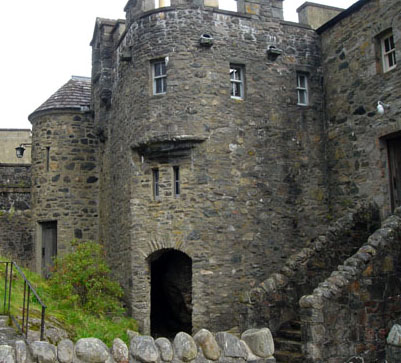
|
| A Most Impressive Entryway |
Today visitors cross from the lochside over
a stone arched causeway to the forecourt and main entrance. Passing through the main doorway under the portcullis and entering
the courtyard, the plan of the stronghold is revealed. After lowering the portcullis the outer walls were defended but, if
these fell, the besieged withdrew and held the inner fortress.
| Eilan Donan Castle Porticullis |
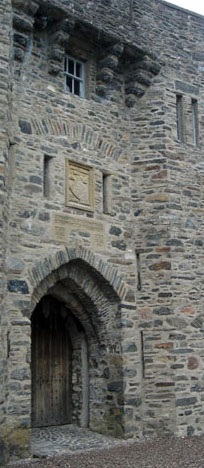
|
| This is the entryway to Eiland Donan Castle |
Over the portcullis
can be seen a Gaelic inscription which, translated reads:
" As long as there
is a Macrae inside
There will never be a Fraser outside"
The Castle Constables on Patrol (C.O.P.'s)
| Eilean Donan Castle |

|
| At Kyle of Lochalsh where the Skye Road Bridge crosses to Kyleakin in Skye. |
Scant respect for the law was being shown by
the region, and it was here that Randolph's "Crownare"- crown officer - beheaded fifty local misdoers and exhibited their
heads around the battlements of Eilean Donan Castle as a grim warning to others. The Macraes, who formed the bodyguard of
the Chief of Kintail and were known as "MacKenzies Coat of Mail", first became Constables of the Castle in 1509. They took
control of the area and the Clan was involved in many raids and sieges. One such epic occasion occurred in 1539 when Donald
Gorm, a Lord of the Isles, lead 400 warriors in an attack on the Castle. The Acting Constable, Duncan MacRae, withstood the
assault; he successfully defended the Castle and, with
his last arrow, fatally wounded Donald Gorm.
In 1719, at the time of an unsuccessful
Jacobite rising in favour of the Old Pretender, the Spanish, who were assisting the Jacobites, sent an expeditionary force
to Scotland and set up their headquarters at Eilean Donan Castle. On 10th May, 1719, three English frigates, Worcester, Enterprise
and Flamborough, under the command of Captain Boyle, sailed into Loch Alsh and attacked Eilean Donan. The Castle, defended
by only forty-eight Spaniards commanded by a captain and Lieutenant, fell after a short bombardment to the superior artillery
fire, and the Spanish soldiers surrendered. Taken aboard the frigates, the Spanish soldiers were shipped back to Leith and
imprisoned there. The rising ended one month later on 10th
June with the defeat of the jacobites (poorly provisioned and armed) at the Battle of Shiel.
The stark ruins of the once proud
Castle were to remain neglected for 200 years until the restoration by a MacRae of the twentieth century. Lt.-Col. John MacRae-Gilstrap,
grandfather of the present Constable of Eilean Donan, rebuilt the Castle with the aid of Farquhar MacRae, who had seen a vision
of the ruined stronghold restored to its former glory. The dream became a reality for, in the twenty years between 1912 and
1932 and at a cost of a quarter of a million pounds, the Castle was rebuilt. Every detail of the restored structure was faithful
to the original which was revealed to Farquhar MacRae in his dream, and later confirmed by old plans of Eilean Donan preserved
with other records in Edinburgh Castle.
How To Get To Eilean Donan Castle
| Eilan Donan Castle |
|
|
| Map - How to Get to Eilean Donan Castle |
Travellers from the south and east
join the A87 at the head of Loch Cluanie. The road
winds through Glen Shiel - passing the battlefield which is marked by a cairn at the roadside. The Glen ends at Shiel Bridge,
at the head of Loch Duich. The road the bears right and follows the northern shore of the loch to Eilean Donan and Dornie;
the old highway over Carr Brae forks right from Inverinate into the village of Dornie. This road affords spectacular views
of the castle and surrounding countryside.
The bridge at Dornie takes
the main highway over Loch Long to Ardelve; a few miles beyond there is a right fork which leads to Strome Ferry and the north-west
Highlands. Continuing westwards, however, the main road terminates at Kyle of Lochalsh where the Skye Road Bridge crosses
to Kyleakin in Skye.
| How To Get To Eilean Donan Castle |
|
|
| The Five Sisters of Kintail |
The countryside surrounding Eilean
Donan Castle is of exceptional beauty and grandeur with breathtaking mountain, loch and forest scenery. Moist west winds from
the Atlantic give a soft and tender climate. Rich in wildlife, the area offers fascinating rewards to the observant nature lover. There are Otters
and Seals, Wild Goats, Red and Roe Deer, whilst overhead may be seen ravens, Buzzards, Falcons and the Golden Eagle.
The impressive Falls of Glomach,
near Dornie are well worth the long hard climb up to them. One of the highest in Britain, the falls include a sheer drop of
300 feet and a further fall of 50 feet from a projecting ledge to the bottom pool.
Dornie is the mini-capital of Kintail
and an ideal centre for exploring from Loch Hourn To Torridon and the Isle of Skye. It is a haven for naturalists, walkers
and the more ambitious who choose to climb the Five Sisters of Kintail or the Cullin mountains. Boat hire and fishing tackle
are available locally. In the cool of the evening you can take it easy and relax in any of the local hotels.
Starring Roles
| Eilean Donan Castle Starring Roles |
|
|
| Action Scene During the Shooting of "HIGHLANDER" in 1985. Sean Connery, starring. |
Eilean Donan and it's magnificent setting draws
visitors from the world over, but for those who have not experienced the magical reality they have almost certainly seen the
castle in a myriad of guises on the big and small screens. Most famous, perhaps, is the castle's role in Highlander starring
Sean Connery and Christopher Lambert.
But there is also Loch Ness with Ted danson,
The Master of Ballintrae with Errol Flynn or perhaps you may have seen it in a Bond movie? And nationally, for how long will
we remember the Avengers, the BBC balloon drifting over the island or The Clothes Show wedding of the year in 1998. Eilean
Donan will undoubtedly continue in it's starring role.
| Eilean Donan Castle Starring Roles |
|
|
| Even Her Majesty's Own Best Know Agent, James Bond 007 (license to kill) could not stay away in 1999 |
When You Visit Eilean Donan Castle...
| Eilean Donan Castle |
|
|
| Watercolors Painting by Hugh Tuckeman |
Location:
Eilean Donan Castle is located about 8 miles
from the Kyle of Lochalsh on the A87 road near the Isle Of Skye. See map for details.
Opening Hours:
The castle and exhibitions are open from 01/04
to 30/10 daily from 10.00am to 5.30pm. Admission charge is £3.75 for Adults. Visitors must purchase
a ticket during opening time in order to wander round the castle. Visitors can wander round the castle surroundings after
the castle is closed for free. Tickets are purchased in the new visitor centre before visiting the castle. Tickets must be
surrendered at the gatehouse before the castle causeway. Last admission to the castle is at 5.30pm.
Visitor Centre:
The visitor centre which was opened in 1998
has a gift shop, toilets, ticket office and a café and is
open from 01/04 to 31/10 every day from 10.00am to 5.30pm. The gift shop is open all year round.
Weddings:
It is possible to get married in the castle
or too renew your vows.
Phone Numbers:
The castle can be contacted on 01599-555202
or faxed on 01599-555262. Please ask for Mr Rod Svenson the Castle Curator.
|
 |
|
|
 |
|
|
 |
|
|
|
|
It is my sincere hope that you have enjoyed learning about Eilean
Donan Castle as much as I enjoyed compiling them for your viewing pleasaure!
Pipe Major Dr. Raphael Pazo, Jr.
Music of Elegance
and Distinction by
Dr. Raphael Pazo, Highland Bagpiper californiabagpiper.com
© 2004-2019 All Rights Reserved.
|
|
|
 |
